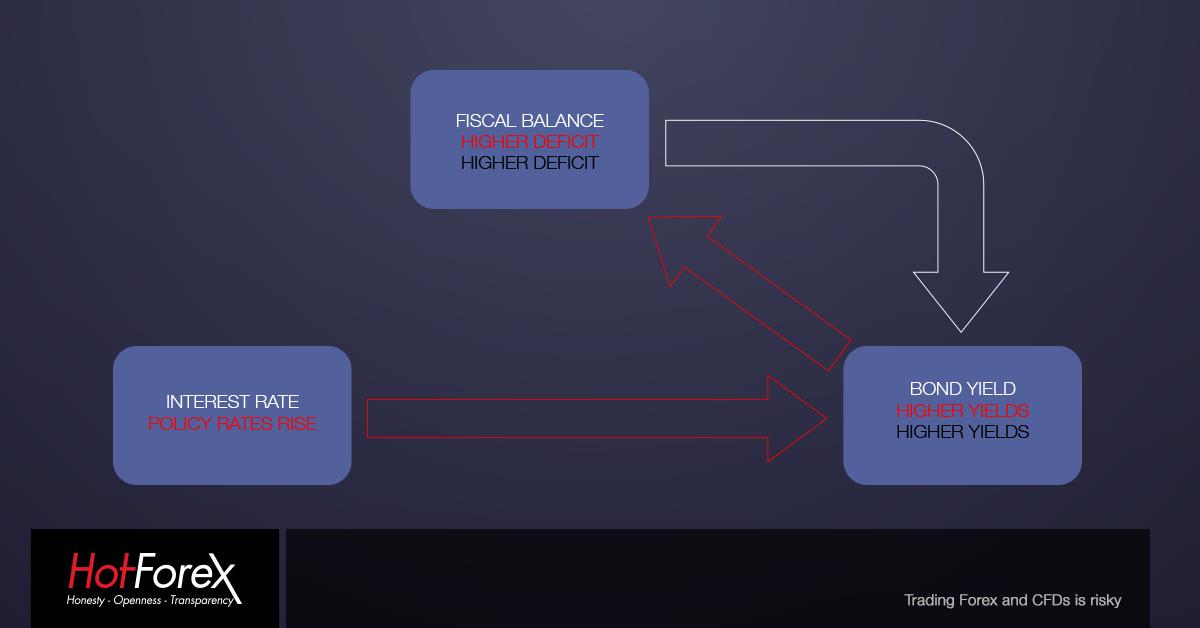The US fiscal deficit for the fiscal year 2018 was just reported to have increased to $779 billion, or approximately 4% of GDP for the period. As Reuters notes, the deficit has been the largest reported since 2012, during a time when elections were coming up and the economy was still at a low interest rate environment and perhaps also in need for more government spending. It is known that bond traders keep a close eye on fiscal and monetary developments. In the latest post on Fiscal Policy, I have commented how interest rates affect government finances but I have left one important piece out of the equation: how Fiscal Deficits themselves affect bond yields.
Overall, recall that higher interest rates, or even expectations of higher interest rates, cause bond yields to rise, given that investors demand higher compensation for their money as interest rates increase. This leads to raising the cost of borrowing for the government, which in turn leads to higher deficits, all else equal. Naturally, it could most likely be the case that interest rates have increased because of improved economic conditions and hence more taxes will be flowing in to cover for the raise in the bond yield.
Another important point is that fiscal deficits tend to also increase bond yields simply because there is more debt running for the same amount of investor funds. As such, investors can potentially gain higher compensation as demand for their funds has increased. Furthermore, the higher the deficit, the more unlikely it is that the state will remain able to meet its repayments. Consequently, higher, persistent deficits are indicative of higher risk in the economy as potential fiscal actions would need to be taken in the future, i.e. increases in taxation or spending cuts. This surge in non-payment risk is bound to increase yields as well.
In the case of the US, the current situation is indicative of both happening at the same time: the government keeps maintaining a large fiscal deficit and the Federal Reserve is on a bout of interest rate increases which should not end soon. The policy-important question is what happens to the economy when the government is forced to slash spending or increase taxation in order to maintain a sustainable fiscal position. As studies have shown, drops in spending can result to approximately one-for-one reductions in the GDP growth rate, although this effect is mostly observed in periods of recession. Still, in the US case, even a 0.5% drop in GDP growth for a 1% reduction in government spending could have important effects on its growth potentials, especially if it also constraints fiscal space during a recession. The US bond yield has been reflecting these developments as its price has been declining, which suggests that the bond yield is increasing. In fact, the combination of the two effects has sent the yield at more than 3% in September, for the first time since 2011.
Disclaimer: Nothing in this communication contains, or should be considered as containing, an investment advice or an investment recommendation or a solicitation for the purpose of purchase or sale of any financial instrument.
Recommended Content
Editors’ Picks
EUR/USD extends gains above 1.0700, focus on key US data

EUR/USD meets fresh demand and rises toward 1.0750 in the European session on Thursday. Renewed US Dollar weakness offsets the risk-off market environment, supporting the pair ahead of the key US GDP and PCE inflation data.
USD/JPY keeps pushing higher, eyes 156.00 ahead of US GDP data

USD/JPY keeps breaking into its highest chart territory since June of 1990 early Thursday, recapturing 155.50 for the first time in 34 years as the Japanese Yen remains vulnerable, despite looming intervention risks. The focus shifts to Thursday's US GDP report and the BoJ decision on Friday.
Gold closes below key $2,318 support, US GDP holds the key

Gold price is breathing a sigh of relief early Thursday after testing offers near $2,315 once again. Broad risk-aversion seems to be helping Gold find a floor, as traders refrain from placing any fresh directional bets on the bright metal ahead of the preliminary reading of the US first-quarter GDP due later on Thursday.
Injective price weakness persists despite over 5.9 million INJ tokens burned

Injective price is trading with a bearish bias, stuck in the lower section of the market range. The bearish outlook abounds despite the network's deflationary efforts to pump the price.
US Q1 GDP Preview: Economic growth set to remain firm in, albeit easing from Q4

The United States Gross Domestic Product (GDP) is seen expanding at an annualized rate of 2.5% in Q1. The current resilience of the US economy bolsters the case for a soft landing.

